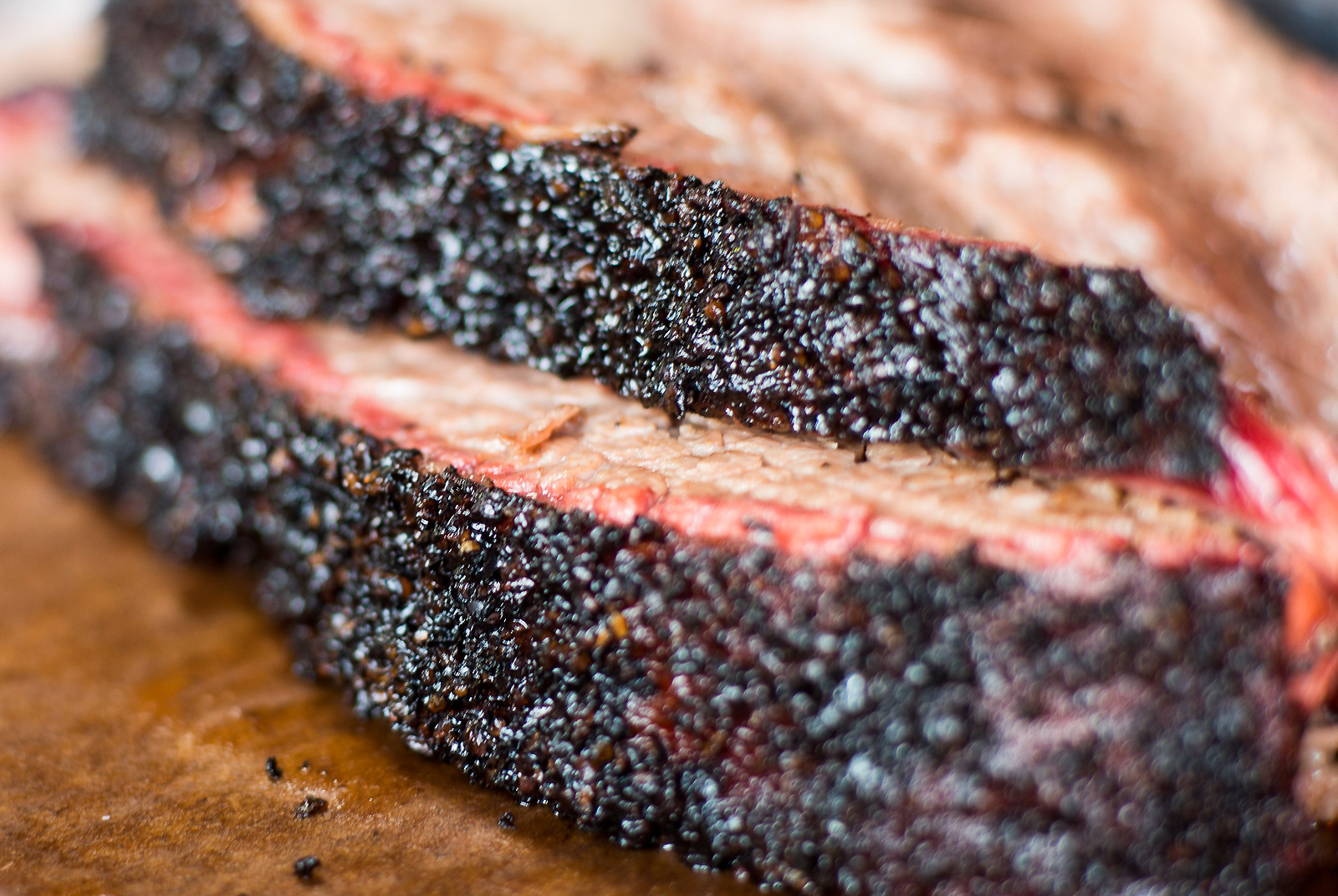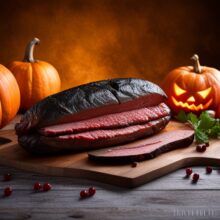How to Make a Bark Brisket

To make a great layer of bark on your brisket, you need to do a couple of things. First, trim off any excess fat. Excess fat creates too much moisture and can prevent the bark from forming evenly. Trimming the fat is easy and will help you achieve an excellent bark. Next, you need to add a sugar-based dry rub. The sugar will melt and add flavor while forming the crusty goodness. Just be sure not to add too much sugar or you’ll risk burning the meat.
Creating a good layer of bark on a brisket
The secret to a good layer of bark on your brisket is to cook it at a high enough temperature to develop a crisp outer surface. The ideal cooking temperature is between 225 and 250 degrees Fahrenheit. If you cook at a lower temperature, the meat will not produce any bark. However, the amount of sugar in your rub will affect the appearance of the bark.
In order to get a good layer of bark on a cut of meat, you need to use a good food thermometer. You cannot get the best results with a cheap thermometer, so make sure to use one of the top brands such as ThermoPro. As a rule, most dry rub recipes will work fine for creating a layer of bark, but you should use a rub that has a good balance of sugar and salt.
After you have chosen the right wood, the next step is to make the rub. If you are using a home-made rub, you will need to spend some time in preparing it. Also, you need to determine the ideal temperature for smoking your meat. You want to smoke it at a temperature that’s just right for its particular flavor and texture. If you cook it at a low temperature, your meat will dry out too quickly and your bark will be flat and won’t have any flavor.
Creating a good layer of bark on your beef brisket is important for a perfect barbecue. This layer of flavor protects your meat from overcooking. By using a proper rub, you can increase the flavor of your meat.
The fat content of your meat is critical in the formation of a good layer of bark. You must be careful not to over-rub it, as the fat content can prevent the outer layers from receiving oxygen and heat. While fat is necessary for the formation of a good layer of bark, too much fat will make the process of forming the pellicle impeded and prevent the proteins from getting the necessary exposure to heat and oxygen to build a good bark.
When choosing a rub, make sure to consider the amount of salt, sugar, and spices. Salt and sugar are water-soluble and can penetrate the meat. The rest of the ingredients stay on the surface and help form the bark.
Getting a good layer of bark on a brisket
Getting a good layer of bark on your brisket is possible if you follow some basic steps. First, you must remove any excess fat from the meat. This will increase the surface area and allow the rub to penetrate better. Another trick is to cut the meat into two pieces, criss-cross style.
There are 6 key factors that contribute to the formation of the bark on your brisket. These factors are: oxygen, temperature, fat content, choice of wood, spice rub, and cooking time. A good layer of bark will be achieved at 250 degrees Fahrenheit.
The bark on a brisket is a natural product of the Maillard Reaction. This chemical reaction takes place in the meat while cooking it. This is a process that causes the meat to develop layers of flavor and color. It is a natural product of the smoke produced during cooking. During this process, the smoke binds with the spices that are on the brisket’s surface.
To ensure a good layer of bark on a beef brisket, it is essential to use a good food thermometer. A cheap one is not sufficient and will not give the desired results. A thermometer like the ThermoPro is the best option. Another important thing to remember when making a bark is the dry rub recipe. It should contain plenty of salt and sugar to help form the layer.
A brisket with a good layer of bark on it will be crispy and have a caramelized surface. The bark is made up of juices from the meat, fat from the outside of the meat, and spices. There are many different kinds of brisket rubs available in the market. Each style uses different spices and ingredients.
The choice of meat also plays a vital role in the production of a good layer of bark. Certain cuts of meat have a high percentage of fat that keeps the meat moist and juicy during a long smoking session. While these meats are generally easier to smoke and develop a great layer of bark, you can also try using other types of meat.
Creating a great layer of bark on a brisket with a dry rub
Dry rubs are an important part of any barbecue, but the key to creating a great layer of bark is to be sure the meat is completely dry before applying the rub. Don’t baste or spray the meat before applying the rub. This prevents the meat from being overly moist, which will lead to a slower-cooking meat. Wrapping the meat in foil before cooking can help speed up the process and make the bark easier to apply. If you don’t use foil, the bark may stay hard and won’t get as crispy.
Briskets are the most popular cuts for creating a bark, since they’re flat and have ample surface area to rub with spices. However, pork ribs and baby back ribs can also work well. If you’re using pork, trim the fat as much as possible before cooking. While the fat helps produce a juicy layer on your meat, a thin layer of fat is necessary to dissolve the spices.
The process of creating a great layer of bark is very important and involves careful preparation and proper air flow. You should consider the amount of spices, fat, and cooking temp. Make sure the mixture is well seasoned. This helps the bark stay intact to the meat and adds a rich, flavorful layer.
Another important step is basteing. Baste the brisket every half an hour or so to introduce moisture. This step is vital to creating a good layer of bark on your brisket. Once the brisket has been roasted for about two hours, you can stop basting. Basting adds moisture during the first phase of cooking and prevents the chemical reaction that results in the formation of bark.
Another important aspect of barking is the temperature. You should keep the temperature of the meat below 300 degrees Fahrenheit. If the temperature is too high, the bark won’t form. The ideal temperature is 225 – 250 degrees Fahrenheit. Table sugar doesn’t caramelize until it hits this temperature. Also, make sure you don’t open the barbecue lid while cooking. Otherwise, you may cause uneven cooking.
Another key factor when creating a great layer of bark on a meat is fat content. If there is too much fat on the meat, it may not produce a good layer of bark. Moreover, too much fat will clog the meat’s pores and prevent it from rendering. As a result, you need to balance the fat content when preparing your rub.
Creating a great layer of bark with a wet rub
If you want to create a great layer of bark on your bark brisket, the first thing you need to do is choose the right cut of meat. There are specific cuts of meat that develop beautiful layers of bark and have the right amount of fat to stay juicy through a long smoking session. Experiment with different meat types to find out which one works best for you.
The first three to four hours of cooking time are critical to creating a great layer of bark on your bark brisket. During this time, you don’t need to spritz the meat or mop it. This is the time to let the flavor of the rub develop. After this time, you can start spritzing the meat every hour, or every half hour. This will ensure the rub has the opportunity to develop a crust on the brisket.
Another important factor in creating a great layer of bark on your bark brisket is the temperature. The higher the temperature, the darker the bark will be. If the temperature is too high, the meat will dry out inside and too low, it will fail to develop a thick layer of bark. A temperature of 225 to 235 degrees (f) is a good range.
Using sugar can help to promote the formation of bark, but be careful not to burn it. Burning sugar will create a bitter flavor. Pre-mixed seasoning rubs are easy to find at your local supermarket. You can use about a tablespoon of the rub per pound of meat. Leaving the meat un-wrapped for the first few hours of cooking will help to absorb the smoke and develop the bark. Mopping or spraying the meat will actually do more harm than good.
The process of creating a great layer of bark on a brisket is not difficult but requires some experimentation. The important thing to remember is that the bark should be crusty to prevent the meat from shrinking too much when wrapped in foil. A thin layer of bark will be more difficult to develop. If it’s too thin, the meat will not be able to survive the wrapping phase. Once you’ve achieved a crusty bark on your brisket, you can continue cooking until the internal temperature reaches 150 deg F or 160 deg F.
Read more great BBQ articles at Bob's BBQ Tips
Did you miss our previous article…
https://notoriousbob.net/?p=2352



